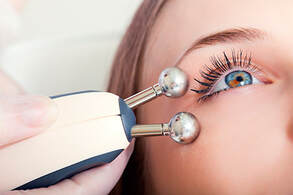|
Facelifts are invasive, Botox is expensive, and anti-aging serums or creams don’t ever seem to work. Well, move over Botox, there’s an anti-aging facial — often referred to as a “natural facelift” — that has burst onto the beauty scene, and it actually works. This magical treatment, known as a microcurrent facial, uses electrical currents to boost collagen production, tighten the skin, and lift the facial muscles. It is FDA approved, safe, painless, and no needles are ever involved. Keep reading to learn more about microcurrent facials and where to take advantage of this amazing treatment locally.
A microcurrent facial uses two handheld metal wands that give off electrical currents, one positive and one negative. It stimulates the muscles in the face and increases the production of collagen and elastin in the skin. Microcurrent treatments are safe and effective, as they have been around for years and have even been used in the medical industry to help patients with conditions such as Bell’s Palsy. Due to the electrical current, however, pregnant women and clients that have a pacemaker should not receive a microcurrent facial.
0 Comments
|
Archives
February 2024
Categories |

 RSS Feed
RSS Feed